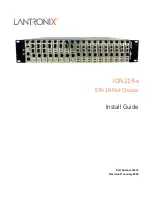
1-2
Cisco ASA Series CLI Configuration Guide
Chapter 1 Configuring Threat Detection
Configuring Basic Threat Detection Statistics
Configuring Basic Threat Detection Statistics
Basic threat detection statistics include activity that might be related to an attack, such as a DoS attack.
This section includes the following topics:
•
Information About Basic Threat Detection Statistics, page 1-2
•
Guidelines and Limitations, page 1-3
•
•
Configuring Basic Threat Detection Statistics, page 1-4
•
Monitoring Basic Threat Detection Statistics, page 1-5
•
Feature History for Basic Threat Detection Statistics, page 1-6
Information About Basic Threat Detection Statistics
Using basic threat detection statistics, the ASA monitors the rate of dropped packets and security events
due to the following reasons:
•
Denial by access lists
•
Bad packet format (such as invalid-ip-header or invalid-tcp-hdr-length)
•
Connection limits exceeded (both system-wide resource limits, and limits set in the configuration)
•
DoS attack detected (such as an invalid SPI, Stateful Firewall check failure)
•
Basic firewall checks failed (This option is a combined rate that includes all firewall-related packet
drops in this bulleted list. It does not include non-firewall-related drops such as interface overload,
packets failed at application inspection, and scanning attack detected.)
•
Suspicious ICMP packets detected
•
Packets failed application inspection
•
Interface overload
•
Scanning attack detected (This option monitors scanning attacks; for example, the first TCP packet
is not a SYN packet, or the TCP connection failed the 3-way handshake. Full scanning threat
detection (see the
“Configuring Scanning Threat Detection” section on page 1-15
) takes this
scanning attack rate information and acts on it by classifying hosts as attackers and automatically
shunning them, for example.)
•
Incomplete session detection such as TCP SYN attack detected or no data UDP session attack
detected
When the ASA detects a threat, it immediately sends a system log message (733100). The ASA tracks
two types of rates: the average event rate over an interval, and the burst event rate over a shorter burst
interval. The burst rate interval is 1/30th of the average rate interval or 10 seconds, whichever is higher.
Model
License Requirement
All models
Base License.
Summary of Contents for 5505 - ASA Firewall Edition Bundle
Page 28: ...Glossary GL 24 Cisco ASA Series CLI Configuration Guide ...
Page 61: ...P A R T 1 Getting Started with the ASA ...
Page 62: ......
Page 219: ...P A R T 2 Configuring High Availability and Scalability ...
Page 220: ......
Page 403: ...P A R T 2 Configuring Interfaces ...
Page 404: ......
Page 499: ...P A R T 2 Configuring Basic Settings ...
Page 500: ......
Page 533: ...P A R T 2 Configuring Objects and Access Lists ...
Page 534: ......
Page 601: ...P A R T 2 Configuring IP Routing ...
Page 602: ......
Page 745: ...P A R T 2 Configuring Network Address Translation ...
Page 746: ......
Page 845: ...P A R T 2 Configuring AAA Servers and the Local Database ...
Page 846: ......
Page 981: ...P A R T 2 Configuring Access Control ...
Page 982: ......
Page 1061: ...P A R T 2 Configuring Service Policies Using the Modular Policy Framework ...
Page 1062: ......
Page 1093: ...P A R T 2 Configuring Application Inspection ...
Page 1094: ......
Page 1191: ...P A R T 2 Configuring Unified Communications ...
Page 1192: ......
Page 1333: ...P A R T 2 Configuring Connection Settings and QoS ...
Page 1334: ......
Page 1379: ...P A R T 2 Configuring Advanced Network Protection ...
Page 1380: ......
Page 1475: ...P A R T 2 Configuring Modules ...
Page 1476: ......
Page 1549: ...P A R T 2 Configuring VPN ...
Page 1550: ......
Page 1965: ...P A R T 2 Configuring Logging SNMP and Smart Call Home ...
Page 1966: ......
Page 2059: ...P A R T 2 System Administration ...
Page 2060: ......
Page 2098: ...1 8 Cisco ASA Series CLI Configuration Guide Chapter 1 Troubleshooting Viewing the Coredump ...
Page 2099: ...P A R T 2 Reference ...
Page 2100: ......


































